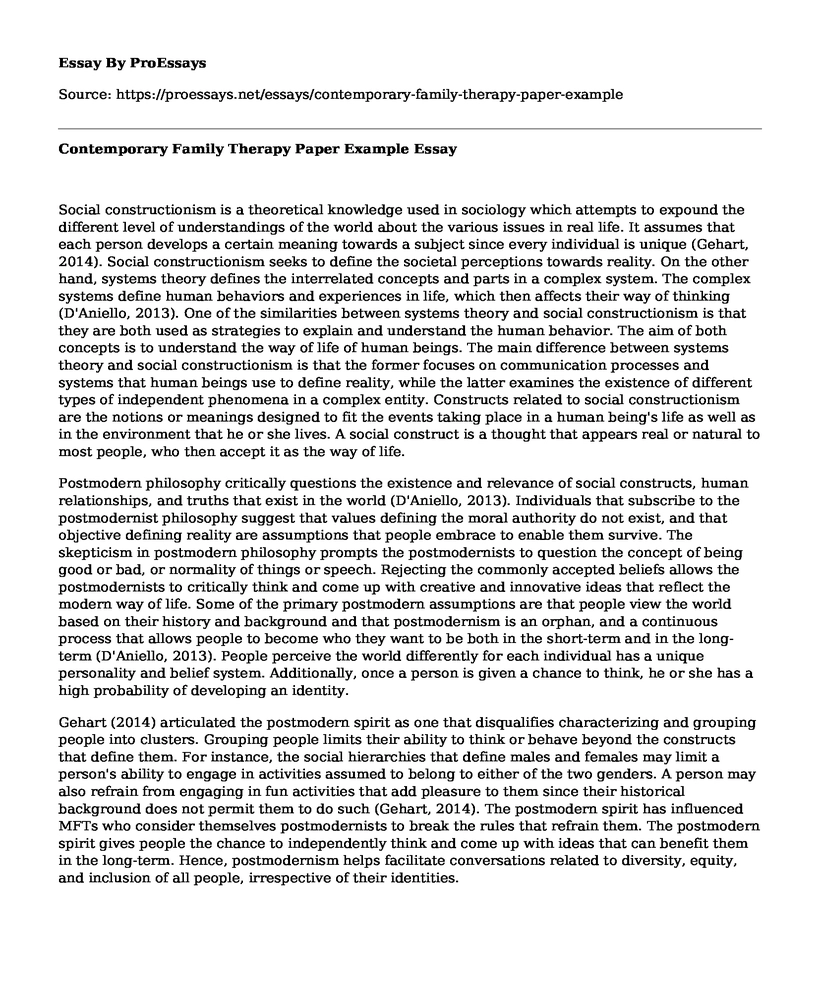Social constructionism is a theoretical knowledge used in sociology which attempts to expound the different level of understandings of the world about the various issues in real life. It assumes that each person develops a certain meaning towards a subject since every individual is unique (Gehart, 2014). Social constructionism seeks to define the societal perceptions towards reality. On the other hand, systems theory defines the interrelated concepts and parts in a complex system. The complex systems define human behaviors and experiences in life, which then affects their way of thinking (D'Aniello, 2013). One of the similarities between systems theory and social constructionism is that they are both used as strategies to explain and understand the human behavior. The aim of both concepts is to understand the way of life of human beings. The main difference between systems theory and social constructionism is that the former focuses on communication processes and systems that human beings use to define reality, while the latter examines the existence of different types of independent phenomena in a complex entity. Constructs related to social constructionism are the notions or meanings designed to fit the events taking place in a human being's life as well as in the environment that he or she lives. A social construct is a thought that appears real or natural to most people, who then accept it as the way of life.
Postmodern philosophy critically questions the existence and relevance of social constructs, human relationships, and truths that exist in the world (D'Aniello, 2013). Individuals that subscribe to the postmodernist philosophy suggest that values defining the moral authority do not exist, and that objective defining reality are assumptions that people embrace to enable them survive. The skepticism in postmodern philosophy prompts the postmodernists to question the concept of being good or bad, or normality of things or speech. Rejecting the commonly accepted beliefs allows the postmodernists to critically think and come up with creative and innovative ideas that reflect the modern way of life. Some of the primary postmodern assumptions are that people view the world based on their history and background and that postmodernism is an orphan, and a continuous process that allows people to become who they want to be both in the short-term and in the long-term (D'Aniello, 2013). People perceive the world differently for each individual has a unique personality and belief system. Additionally, once a person is given a chance to think, he or she has a high probability of developing an identity.
Gehart (2014) articulated the postmodern spirit as one that disqualifies characterizing and grouping people into clusters. Grouping people limits their ability to think or behave beyond the constructs that define them. For instance, the social hierarchies that define males and females may limit a person's ability to engage in activities assumed to belong to either of the two genders. A person may also refrain from engaging in fun activities that add pleasure to them since their historical background does not permit them to do such (Gehart, 2014). The postmodern spirit has influenced MFTs who consider themselves postmodernists to break the rules that refrain them. The postmodern spirit gives people the chance to independently think and come up with ideas that can benefit them in the long-term. Hence, postmodernism helps facilitate conversations related to diversity, equity, and inclusion of all people, irrespective of their identities.
Conclusion
The recovery model is used as a supportive strategy for persons suffering from mental conditions. It allows people to develop a different and positive outlook towards life and create meaning. The primary component in the recovery model includes being a holistic approach towards life. Others include empowerment, client-centered, respect, and self-direction. All components are combined to ensure a client recovers in the long-term and he or she adopts a new purpose in life that helps them have a positive attitude towards life.
References
D'Aniello, C. (2013). Contemporary MFT models' alignment with relational common factors. Contemporary Family Therapy, 35(4), 673-683.
Gehart, D. R. (2014). The mental health recovery movement and family therapy, Part I: Consumerled reform of services to persons diagnosed with severe mental illness. Journal of marital and family therapy, 38(3), 429-442.
Cite this page
Contemporary Family Therapy Paper Example. (2022, Nov 06). Retrieved from https://proessays.net/essays/contemporary-family-therapy-paper-example
If you are the original author of this essay and no longer wish to have it published on the ProEssays website, please click below to request its removal:
- Course Work on Self-efficacy and Self-control
- Cultural Relevance of Mental Health Patient Navigators for Ethnic Minority Groups
- My Biography as a Marriage and Family Therapy Paper Example
- My Avalanche of Kindness Essay Example
- Essay Sample on Person Centered Theory
- Essay Example on Emotional Challenges of Living With Reactive Attachment Disorder (RAD)
- Immaterialism: The Mental Perception of Society & Individuals - Essay Sample







